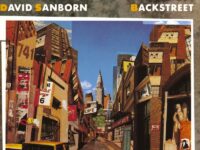Often situated in a pillowy cloud of opaque neo-funk, the late saxophonist David Sanborn’s talents were understandably obscured. The arrangements on his records, like much of the smooth-jazz movement that he still perhaps wrongly personifies, can just be so … agreeable.
Yet Sanborn remained unique in his ability to creatively emote in almost any context, no matter how pallid. Just when you got ready to write him off, Sanborn elevated – be that on any number of jazz-ish solo recordings dating back to his 1975 debut, Taking Off, or on a dizzying number of sideman gigs across the rock and blues genres. There’s just no mistaking, or escaping, that amiable, skirling tone …
“TUESDAY HEARTBREAK,” with Stevie Wonder (TALKING BOOK, 1972): David Sanborn fits so snugly into this song’s layered melancholic funk that, at first, he seems to charge out of the mix at about the midway point of Stevie Wonder’s “Tuesday Heartbreak.” (Wonder, along with producers Malcolm Cecil and Robert Margouleff, after all, had constructed a crashing tide of sound, with wall-to-wall synthesizers, Rhodes and clavinets replacing the more familiar strings associated with funk music.) Repeated listens, however, reveal a soloist of thrifty practicality.
Sanborn is all over the song, but only to provide a measured response amidst Wonder’s pulsing impetuousness. He’s the ground wire as Stevie blurts out an upbeat plea for reconciliation – “I wanna be with you when the nighttime comes. I wanna be with you ’til the daytime comes” – after a breakup. Sanborn’s call-and-response sax work, like a sharp warning, balances that optimism with a bracing shot of deep-blues reality.
Across Stevie Wonder’s five-album outburst of 1970s pop-soul brilliance (from 1972’s Music of My Mind through 1976’s Songs in the Key Of Life), the thing to completely and utterly love has always been his unconquerable opened-heartedness. Here, David Sanborn communicates all of the dark outcomes that we know to be part of the deal, as well. – Jimmy Nelson
“RAMBLIN'” (UPFRONT, 1992): To pigeonhole David Sanborn as some smooth-jazz icon starts to look pretty silly the more you dig into his music. I mean, how many smooth jazzers do you know who played in Paul Butterfield’s band when it was still relevant, hooked up with Tim Berne on a tribute to Julius Hemphill, or covered an Ornette Coleman ditty on his own record?
I suspect that Sanborn chose to take on Coleman’s “Ramblin'” because he really didn’t have to mess with it much to make it his own song. Like most of Coleman’s tunes, there aren’t really chords but a definite succession of notes, and that melody doesn’t rely on rhythm to stand on its own. Coleman himself put a bop spin on his blues melody when he taped the original version in 1959. Sanborn swipes that melody intact and slips in a sweaty, organic funk groove underneath. Drummer Steve Jordan, guitarist Spaceman Patterson and B-3 player Ricky Peterson worked that groove vigorously for eight minutes, while Sanborn and trumpeter Herb Robertson (his Don Cherry stand-in) teach classic Harmolodics to fans who might have been too frightened to give Change of the Century a spin.
David Sanborn himself didn’t fear the avant garde-father Coleman and, in making a dance-ready rendition of “Ramblin’,” he suggested that his audience needn’t, either. – S. Victor Aaron
“MAPUTO,” with Bob James (DOUBLE VISION, 1986): This pairing – considered big news in the world of pop-jazz back then – had all the makings of a made-for-the-cutout-bin easy-listening disaster. Whatever you thought about David Sanborn, he was George Clinton-level crazy-soulful compared to the drab keyboardist-about-town Bob James – a player who, even decades later, tended to spend most sessions ensuring that things don’t become too interesting. Then these two go and open Double Vision with a composition by bassist Marcus Miller that has all the complexity of boxed white wine. Zzzzzzzz, right?
Yet this may be one of the best smooth jazz (I know; stop it) efforts there ever was. Mostly, because “Maputo” definitively confirms everything there was to like about Sanborn – his easy way with a melody, those chunky blasts of bright emotion, his direct thought process, a tone so accessible it would have shamed Cannonball Adderley. Sanborn didn’t just save the song, he single-handedly powered Double Vision – well, with a smart assist from Al Jarreau – toward an amazing 63 weeks on the Billboard chart.
Maybe “Maputo” is an empty-calorie pleasantry, with all of the faux-lushness of pleather. But it definitively illustrates how Sanborn can turn almost anything into listenable – hell, fantastic – pablum. – Jimmy Nelson
“YOUNG AMERICANS,” with David Bowie (YOUNG AMERICANS, 1975): In 1975, David Bowie – former flaxen-haired folkie, then power-pop maven, then bi-sexual balladeer, then space-cadet rocker – announces he’s ditching it all for soul music. “I’ve rocked,” Bowie famously asserts, in a moment of complete bologna, “my roll.” Amongst the rabble of ace session guys he assembles for the resulting project is David Sanborn – who proceeds to wail his way through the album-opening title track, tearing into a series of blurting, lascivious runs.
Sanborn, in fact, ended up dominating “Young Americans” to the point where he’s almost working in duet with Bowie’s vocal. More particularly, his sax sound is like something you’d hear wafting out of an ass-whipping country saloon, or else a strip joint. Those nasty little asides scuffed up this new oddity (Bowie called it “plastic soul”), and people took notice. The track was one of Bowie’s highest charters to date, reaching No. 28 on the Billboard chart at the time – and eventually ranked 481st on Rolling Stone magazine’s list of the 500 greatest songs. Bowie’s brief disco-fied R&B sideroad also propelled him into a spot as one of the few white guys – and was there anybody who was, you know, whiter? – to appear on TV’s Soul Train.
Reason: David Sanborn. – Jimmy Nelson
“I TOLD U SO” (BACKSTREET, 1983): There wasn’t a whole lot of great contemporary jazz going on in the early 1980s, as the wild improvisations and raw musicianship of the ’70s had nearly completely given way to the slick, synthed-up glossed-over production values that made it possible for players with even marginal talent to gain fame and sell a lot of records. Yet Sanborn’s music only got better during this time.
Ever sensitive to modern trends and never pretending to be a straight jazzman in the first place, Sanborn enthusiastically went with the flow – as he mostly did throughout his career – when he issued Backstreet in 1983. But the album defied the odds of becoming instantly forgettable disposable instrumental music because the production (provided primarily by bassist extraordinaire Marcus Miller) and the material were both consistently above par. Right from the beginning, in fact.
The album-opening “I Told U So” is a sublime slice of sultry, mid-tempo funk. Somewhat unusual for its time, there’s real space between the drums, keyboards and bass which makes the sound lean and efficient, creating the perfect slab of groove for Sanborn to work his magic. Sanborn plays it straight over the first couple of choruses, then begins improvising nicely with arpeggios and other expressive devices. He never gets ahead or behind the beat. The late lamented Hiram Bullock shares co-writing credit for this song with Sanborn, while supplying a short but sharp blues-based guitar solo.
No one is out to knock you on your ass with the solos, though. This is about working the slow groove, and the mission is accomplished to perfection. Unhurried and unforced, “I Told U So” rocks in kicked-back, head-nodding style. It’s jazz that’s smooth – but “smooth” done the right way. – S. Victor Aaron




